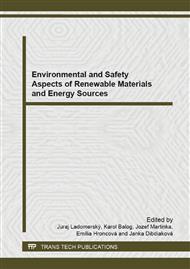[1]
Regulation (EU) No 305/2011 of The European Parliament and of the Council – laying down harmonised for the marketing of construction products and repealing Council Directive 89/106/EEC. Official Journal of the European Union L 88/5. Strasbourg. (2011).
Google Scholar
[2]
ČSN EN 1991-1-2: Eurocode 1: Actions on structures - Part 1-2: General actions - Actions on structures exposed to fire. Prague: Czech Office for Standards, Metrology and Testing, (2004), 56 p. (in Czech).
DOI: 10.1002/9783433601570.oth1
Google Scholar
[3]
ČSN 73 0804: Fire protection of buildings - Industrial buildings. Prague: Czech Office for Standards, Metrology and Testing, (2010) 156 p. (in Czech).
Google Scholar
[4]
Tomašková, M. Study of Psychological Strain of Firefighters. In: EIIC 2012: Electronic International Interdisciplinary Conference, 3-7 September 2012: virtual peer-reviewed conference. Žilina: EDIS, (2012).
Google Scholar
[5]
ČSN 73 0810 (2009). Fire Protection of Buildings – General requirements. Prague: Czech Office for Standards, Metrology and Testing, (2009) 44 p. (in Czech).
Google Scholar
[6]
Pokorný, J., Kučera, P. Calculation of Local Fire for Designing Building Structures. In TRANSACTIONS of the VŠB - Technical University of Ostrava, Safety Engineering Series, Number 1, Vol. VIII (2013).
DOI: 10.2478/tvsbses-2013-0004
Google Scholar
[7]
Heskestad, G. Fire Plumes, Flame Height, and Air Entrainment. SFPE Handbook of Fire Protection Engineering. Fourth Edition, Section Two, Chapter 2-1. Quincy: National Fire Protection Association, (2008), pp.1-20, ISBN-10: 0-87765-821-8.
DOI: 10.1007/978-1-4939-2565-0_13
Google Scholar
[8]
Mózer, V. On equivalent fire exposure. European Journal of Environmental and Safety Sciences. Vol. 1 (2013), pp.18-23. ISSN 1339-472X (printed), ISSN 1339-4797 (on-line).
Google Scholar
[9]
Rantuch, P., Kačíková, D., Nagypál B. Investigation of activation energy of polypropylene composite thermooxidation by model-free methods. European Journal of Environmental and Safety Sciences. Vol. 2 (2014).
Google Scholar
[10]
Martinka, J., Kačíková, D., Hroncová, E., Ladomerský, J. Experimental determination of the effect of temperature and oxygen concentration on the production of birch wood main fire emissions. Journal of Thermal Analysis and Calorimetry Vol. 110 (2012).
DOI: 10.1007/s10973-012-2261-2
Google Scholar
[11]
Pokorný, J. Principles of thermal analysis of Smoke Plume. In proceedings of XVIII year of the international conference Fire Safety 2009 (reviewed journal). Ostrava: VŠB-TUO, FBI, SPBI and HZS MSK, (2009). pp.457-467, ISBN 978-80-7385-067-8.
Google Scholar
[12]
CFAST. Fire growth and smoke transport Modeling with CFAST. In NIST, Fire Research Division, CFAST. [online]. (2014) [cit. 2014-02-27]. Available from WWW: <http: /www. nist. gov/el/fire_research/cfast. cfm>.
DOI: 10.6028/nist.tn.1889v5
Google Scholar


